EHRMusing - You make a lot of accurate statements about key factors in the selection process but the comment about…
News 4/12/13
ONC’s proposed 2014 budget calls for $78 million in spending, up from $61 million in 2013. Staffing will increase from 89 to 109 FTEs. Also in the budget is $1 million in user fees that would be paid by EHR vendors.
Reader Comments
From The PACS Designer: “Re: MyChart. It’s nice to see that TPD’s post on MyChart signup generated a Readers Write from Anonymous along with a large number of reader comments. TPD’s view is MyChart is a good start for an online medical record, but much more needs to be done to add to maximum value for each patient using this option. For MyChart to be used, the patient must request a printed copy of the provider’s existing record. At the very end of the printed record you’ll find a unique starting code, which you will enter once you logon to MyChart. As for lab results, you’ll only get those on your record that the provider has interface installed for those other lab systems. What’s likeable is each medication listed on your record has a link to the National Institutes of Health’s NIH MedlinePlus site, which gives you access to the prescriptions purpose and side effects along with much more information you can’t find on your pharmacist’s prescription fact sheet.”
HIStalk Announcements and Requests

Inga is taking the day off, so I’m sure we all wish her well in whatever interesting activities she has arranged. She mentioned earlier that her sixth anniversary with HIStalk is this week, so perhaps she is celebrating. Here’s to her.
We will be presenting some Webinars shortly and I need three hospital CIOs to provide presenter feedback for the first one. Real-time viewing isn’t required since we will have a recorded practice run of the Webinar to review. It will probably run around 40 minutes. Let me know if you can help. I’ll send an Amazon gift card as my thanks.
On the Jobs Board: Solution Sales Executive, Senior Program Manager, Senior Client Representative.
Welcome to new HIStalk Platinum Sponsor QPID Health Record Intelligence. QPID (Queriable Patient Inference Dossier) aggregates EHR data to support real-time clinician-directed queries, analytics, and reporting capabilities at the point of care. Fast queries are supported by caching and indexing the patient record, with structured and unstructured information parsed and tagged. Any number of rule sets (apps) can be used, with examples that include an EHR search portal, an ED patient summary dashboard, a GI conscious sedation intake system, coding optimization, bronchitis screening, OR diabetes alert, and automated determination of smoking status. I interviewed President and CEO Michael Doyle on the day of the company’s February 14 launch. Thanks to QPID for supporting HIStalk.
Acquisitions, Funding, Business, and Stock

Cerner shares hit a 52-week high Thursday, closing at $95.54, up 30 percent in the past year. Above is the one-year share price chart of CERN (blue) vs. the Nasdaq (red).
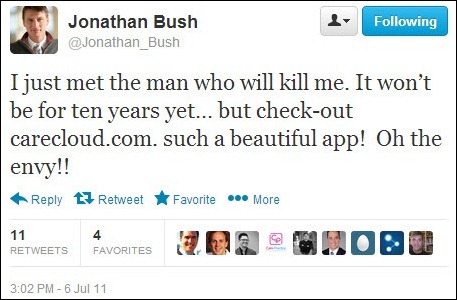
Athenahealth files a patent infringement lawsuit against PM/EHR competitor CareCloud, claiming that the company violated athenahealth’s 2001 patent for claims processing rules. Several former employees of athenahealth now work for CareCloud. Athenahealth declined to comment on the lawsuit, but CareCloud CEO Albert Santalo provided us with this statement:“ To the best of our knowledge Carecloud is not infringing on Athenahealth’s 13-year-old outdated method and we won’t be making any additional comment at this time.”
Sales
Piedmont Healthcare (GA) will deploy Perceptive Software solutions to integrate data directly into its Epic EHR throughout five hospitals and 45 physician offices.
Hennepin County Medical Center (MN) continues its population health drive for HIV care with Forward Health Group’s PopulationManager.
Chris Coburn, executive director at Cleveland Clinic Innovations, will leave that organization to take an unnamed position with Partners HealthCare.
Michael Thompson (Mindray) joins Medstreaming as COO.
Announcements and Implementations
Vocera ships its 500,000th communication badge.
Tennessee-based Parental Health, which offers a care management platform for seniors, will raise $3 million via a Series B fundraising round, with the proceeds going toward the addition of up to 12 full-time employees in sales and marketing.
The Bipartisan Policy Center’s Health Innovation Initiative, Heritage Provider Network, and The Advisory Board company will hold an April 16 discussion on the the use of data by providers, health plans, and states to address healthcare challenges. A big data challenge will be announced. Speakers include Janet Marchibroda (BPC); Senator Bill Frist, MD; Aneesh Chopra (The Advisory Board Company); Karen Ignani (AHIP); and James Weinstein, MD (Dartmouth-Hitchcock Health System). The event will be streamed live.
Intuit Health announces that the seven millionth patient has registered for its health portal.
Practice Fusion launches Patient Fusion, which allows patients to schedule online appointments via the Web with any of the free EHR company’s 27,000 physician users and access their health records online. Mobile versions will follow.
Impact Advisors expands its mergers and acquisitions services for the healthcare IT market.
MMRGlobal files a patent infringement complaint against Quest Diagnostics and its Gazelle personal health records system.
Western Maryland Health System expands its use of Versus RTLS to include a mobile, location-aware call button for caregivers.
Government and Politics

ONC announces internally the hiring of Joe Bormel, MD, MPH (QuadraMed) as Director of Health Outcomes. He will focus on usability, clinical decision, support, and Meaningful Use and certification policy. We reported his hiring as a rumor as ONC medical officer on Tuesday, but did not list his title (“medical officer” in ONC is any physician employee). Bormel will report to Chief Medical Officer Jacob Reider, MD.
The VA requests $3.7 billion for its 2014 IT budget, a 10 percent increase. It includes $252 million for projects related to the VA-DoD shared EHR.
Technology

Athenahealth will provide third-party developer access to its physician network by rolling out an programmer API, allowing creation of an ecosystem of apps that can use its anonymized medical histories, appointments, and billing information through its More Disruption Please program.
Other
In the UK, a hospital suspends its children’s heart surgery program because of high mortality rates, only to find that poorly produced data that had been fed to its new computer system had produced a false alarm.
Weird News Andy calls this “clear thinking for fatheads.” Stanford researchers develop a method of rendering harvested brain tissue transparent by removing the fat in its cells, allowing them to view structures down to the individual cell and molecule level.
Sponsor Updates
- Good Samaritan Hospital chooses Access and Perceptive Software to create electronic forms on demand.
- Vicki Lucas, RNC, PhD, chief nursing officer of PeriGen, covered strategies to increase OB revenue at the World Congress Leadership Summit on The Business of Women’s Health Washington, DC on April 10.
- UMC Health System (TX) goes live on Cerner CPOE with the assistance of HCI Group.
- GetWellNetwork will serve as a patient engagement sponsor for The Academy Huron Institute’s 2013 program “Developing Innovative Value-Based Delivery and Payment Models.”
- T-System signs an exclusive agreement with X32 Healthcare to offer Lean methodology for analytics and services with the ED.
- Hurley Medical Center (MI) selects Ciber to implement its Infor Healthcare Suite.
- Michele Hilton, GM of medical billing services for ADP AdvancedMD shares the top five challenges for hospitals to get paid.
- Merge adds endpoint and adjudication management to its eClinical OS platform for end-to-end study support in a single platform.
- Aprima Medical Software partners with ClearDATA for cloud hosting of its EHR/PM/RCM software and services.
- e-MDs announces the free Kansas City User Group roadshow on May 2.
- MedAssets honors veterans and humanitarians during the 2013 MedAssets Healthcare Business Summit in Las Vegas.
- DrFirst receives the Surescripts 2012 White Coat of Quality Award for the third consecutive year.
- Ingenious Med reaches the milestone of 25,000 charge capture users.
- Levi, Ray & Shoup hosts a webinar April 16 and 18 on improving performance in an SAP environment.
- CTO Charles Halfpenny of Halfpenny Technologies will present a master level session at the 18th Annual Executive War College on the value of lab data to health plans.
- Walsh College (MI) renews its IT outsourcing contract with CareTech Solutions.
- Confirmit awards McKesson its third ACE Award.
- Beacon Partners is hosting a webinar April 19 focusing on five key issues between Stage 1 and Stage 2 of Meaningful Use.
- HealthCare Anytime CEO Brady Klick served on a patient engagement panel at an April 11 program sponsored by the Northern California HIMSS chapter.
- Orion Health celebrates its 20-year anniversary, having surpassed $100 million in annual revenue, raised headcount my three to more than 750, and implement its solutions in more than 30 countries.
EPtalk by Dr. Jayne
Red Raider Alert: Texas Tech University Health Sciences Center notifies patients of an information breach as a result of a billing error. Apparently patient statements were mailed to the wrong addresses.
Mr. H posted a reader question about job recommendations for new graduates to better understand the HIT environment. Depending on your degree and experience, I’d consider looking for a position as an implementation specialist for a hospital, health system, or large medical group. It’s a great way to learn what the industry looks like outside of the vendor space and once you’ve done a couple tours of duty with complicated practices or hospital departments, you’ll be extremely valuable in the job market. At least in my area, teams are often composed of people that are new to healthcare – one is managed by an engineer and includes not only healthcare veterans, but also a minister and several former retirees.
A recent article in American Medical News notes that volume, not quality, still determines most doctor pay. I would love to see payment reform that rewards not only quality, but customer service, personality, and the time spent with patients. Despite the hard edge sometimes portrayed in my writing, when it comes to actual patient care I tend to be much more empathetic than my peers. When I was in community practice, my patients appreciated my listening skills as well as my ability to partner with them and negotiate long-term outcomes rather than simply lecture. Why shouldn’t I be paid more for that level of service? You want to see true physician engagement? Figure out a way to pay primary care physicians so that they can afford to see 20-25 patients a day rather than 30-35. And figure out a fair way to measure Meaningful Use that isn’t “all or nothing.”
Physician social media site Doximity gets my jeer of the week for its unreadable e-mail. It was so bad that I almost outed myself trying to screen shot it – the white rectangle is covering the black-on-black “insert recipient name here” field that I didn’t see until I pasted it over to send to Mr. H. Seriously, folks, do you really think anyone can read black on black or dark gray on black?
Contacts
Mr. H, Inga, Dr. Jayne, Dr. Gregg, Lt. Dan, Dr. Travis.
More news: HIStalk Practice, HIStalk Connect.



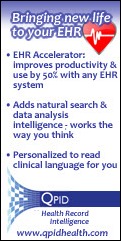


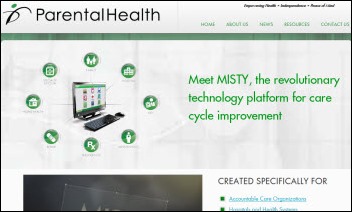

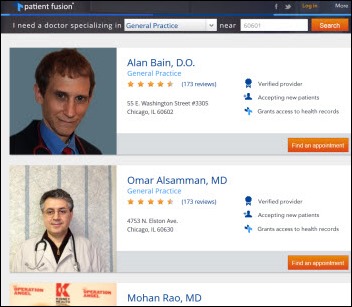


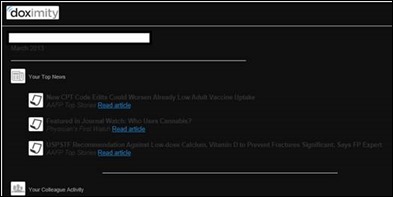


Mr. H – I know there was a ton of noise around John Gomez’s interview on the topic of Epic being open. I was surprised by how often people commented on Epic being close when if they actually watch the announcements on HIStalk, there are routinely posts like this:
Piedmont Healthcare (GA) will deploy Perceptive Software solutions to integrate data directly into its Epic EHR throughout five hospitals and 45 physician offices.
Epic does seek to preserve their customers ability to upgrade safely, but they do also seem to have many, many examples of third parties who are making a fortune doing add ons to Epic while Epic stays its course and focuses on the core of what it does best – integration.
Thought this was interesting feedback directly from UCSF staff on their Epic install:
http://www.kevinmd.com/blog/2013/04/york-times-wrong-health.html
A 26% increase in the ONC budget!
..and ONC now has decided they have done such a good job of boosting CERN (see stock chart above) and all the other EMR vendors revenues/profits ONC wants a real piece of the action.
Vendors already pay about $35k for an EMR certification plus spend a ton of money on internal staff time, but now Dr. M wants his pound of flesh. I wonder where that $1mill will ultimately come from?
Meanwhile the White House has said they’d like to cut $400bill out of provider payments to help balance the budget. Somebody needs to tell Dr. M that the top boss just ‘stole’ his $1mill.
Open Minded,
Perceptive is an imaging “partner” of Epic since Epic does not offer an internal imaging software. When people say they are closed, they mean they don’t support the integration of best of breed solutions or other EMRs. It is true that they will allow basic interfaces with other systems, but interfacing and integration are two very different things.
“What’s likeable is each medication listed on your record has a link to the National Institutes of Health’s NIH MedlinePlus site, which gives you access to the prescriptions purpose and side effects along with much more information you can’t find on your pharmacist’s prescription fact sheet.”
boy oh boy.
Re: MyChart
A couple of thoughts – entering a code to initially log-on. There are options. The option shared by TPD works with the Meaningful Use Workflow of providing a patient with a Visit Summary. The code is at the end of the Visit Summary if the patient isn’t signed up for the portal. IMHO, a good way of killing two birds with one stone, providing the Visit Summary and getting more users to sign-up for a portal in hopes of usage. The latter requires some marketing or other techniques but its a start.
TPD mentions only having the lab results that an organization interfaces. What do people expect? Epic does free work and interfaces labs from all other providers on behalf of the contracting organization? Let’s remember BAAs and the competitive factors in local markets. There are some improvements to the Lab display that would help a consumer.
vendor_neutral says “boy oh boy” to what’s likeable is having a prescription fact sheet. Does vendor_neutral understand that this is “free content”? If you want to connect paid content, you absolutely can but pay through the nose.
Interfacing vs. integration – Is a CCD/CDA-2 interfacing or integration in the language of the commenter? If you do the HARD WORK of defining, mapping and translating YOUR organization’s CCD/CDA-2, the critical information of allergies, meds, problems, vitals, future orders and the like can come across. Has Cerner really deeply “integrated” with some broad third party ED, OB, Critical Care, Oncology, or Surgery System and it works without tremendous man-hours of on-going support and clinicians who trust the data coming across is complete and accurate? Has anything similar been successfully done and replicated quickly and easily with Allscripts, McKesson, MEDITECH, Soarian?
Nobody has the end-all-be-all system. Interfacing is still work. Integration is usually nothing more than single-sign-on, patient context or launching a third party control in context. Its a challenge no matter who the enterprise vendor may be. If someone has done this work, vendor and client, please stand-up and share the details in a case study so we all can learn.
You have TPD commenting on MyChart, a ho hum tethered PHR, Intuit announcing it has reached 7M pts registered to use its PHR (I’d really like to see the usage stats on those 7M as that appears to be a very highly inflated number) and the notorious MMRGlobal, which has morphed itself from a horrid PHR/fax server to a patent troll.
Oh the fun things happening in pt engagement. We have such a long ways to go.
TPD has some interfacing experience with Epic. Back in 1999 after designing and installing a cardiology PACS, the Cleveland Clinic asked us to build an Epicare interface so that cardiologists can view patient data along with their cinefilms. Things worked out so well that word spread fast to other cardiology centers and we had institutions calling us demanding we provide them with the same solution. Today, the solution is the gold standard worldwide for viewing 500MB and up files, and negates the need for a cinefilm viewer! The work back then lead to what is now MyChart for patients.
@ Open Minded–I think you are confusing integration with interfacing. Interfacing push-pull data when an end user requests. Integration is being able to update in one platform while another platform reads and stores that data without end user having to request.
Two very BIG differences.
supply and demand failures of decreased airfare). In case you evaluate the several hours before they require for sign up and screening, the only one